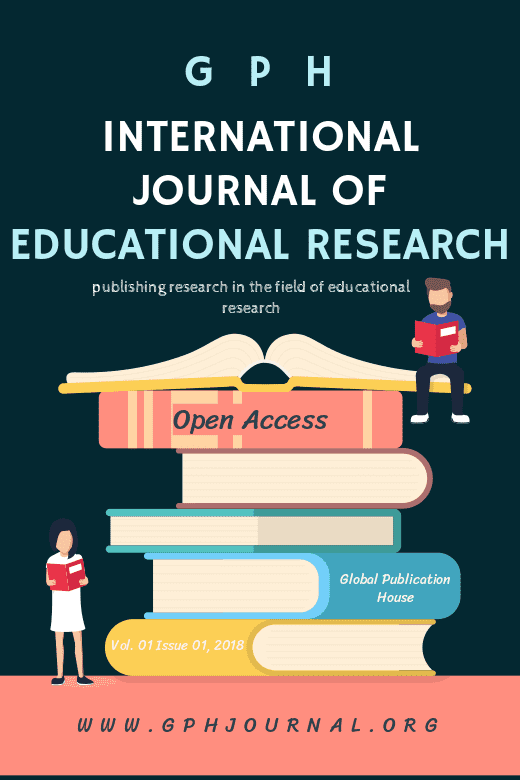School Violence and its Implications on Secondary School Student’s Academic Performance in Nigeria
Abstract
The paper explained the concept of school violence in secondary school and the causes of school violence which include; desperation and despair, mob spirit, hatred and jealousy, alcohol and drug abuse, lax criminal-justice systems, false religion, low self-worth, witnessing violence in the home and many others. It also talked about the types of violence such as the violence of teachers to students, intimidation, exclusion, sexual violence, and so on. The paper also highlighted the effects of school violence on students’ academic performance which leads to internalizing abuse-related distress as a harsh consequence of poor academic performance. It also highlighted some measures to adopt to minimize school violence which include an adaptation of physical security measures, and implement of policies designed to prevent violence. Conclusively, there is an increased need to address the effects of violence on academic progress and the pro-social classroom behavior of students.
Downloads
References
Elendu, I. C. (2014).Nigeria‟s debased values system at the modern era: Implication for sports development. Journal of Education and Practice 3(3), 48-53.
Dabu, J. T. (2011). Impact of spousal abuse on marital adjustment of couples in North-West senatorial district of Benue State.Unpublished master of education (M.Ed.) dissertation, Benue State University, Makurdi.
Berta, E. (2007). Conceptualizing violence: Present and future development in international law. Retrieved 6th December, 2020 from www.aaets.org/joinacademy/joinus.htm.
Aihie, O. N. (2009). Prevalence of domestic violence in Nigeria: Implications for counselling. Edo Journal of Counselling, 20(1), 1-8.
Fusco, R. A., &Fantuzzo, J. W. (2009). Domestic violence crimes and children: A population-based investigation of direct sensory exposure and the nature of involvement. Children and Youth Services Review, 31(2), 249-256.
Aisenberg, E., Trickett, P. K., Mennen, F. E., Saltzman, W., &Zayas, L. H. (2017). Maternal depression and adolescent behaviour problems: An examination of mediation among immigrant Latino mothers and their adolescent children exposed to community violence. Journal of Interpersonal Violence, 22(8), 1227-1249.
Baron, D., &Bryne, U. (2015).Nonviolent aspects of inter-parental conflict and dating violence among adolescents.Journal of Family Issues, 30(3), 295-319.
Bostock, J., Plumpton, M., & Pratt, R. (2017). Domestic violence against women: Understanding social processes and women’s experiences. Journal of Community & Applied Social Psychology, 19(11), 95-110.
Burnham, J. J. (2019). Contemporary fears of children and adolescents: Coping and resiliency in the 21st century. Journal of Counselling and Development, 87(1), 28-35.
Carlson, B. E. (2010). Children exposed to intimate partner violence: Research findings and implications for intervention. Trauma, Violence, and Abuse, 1(4), 321-342.
Carpenter, G. L., & Stacks, A. M. (2011). Developmental effects of exposure to intimate partner violence in early childhood: A review of the literature. Children and Youth Services Review, 31(5), 831- 839.
Ceballo, R., Dahl, T. A., Aretakis, M. T., & Ramirez, C. (2011). Inner-City children’s exposure to community violence: How much do parents know? Journal of Marriage and the Family, 63(4), 927-940.
Close, S. M. (2012). Dating violence prevention in middle school and high school youth.Journal of Child and Adolescent Psychiatric Nursing, 18(1), 2-9.
Fantuzzo, J. W., & Mohr, W. K. (2019).Prevalence and effects of child exposure to domestic violence.The Future of Children, 9(3), 21-32.
Finkelhor, D., Turner, H., &Ormrod, R. (2016). Kid’s stuff: The nature and impact of peer and sibling violence on younger and older children. Child Abuse & Neglect, 30(6), 1401-1421
Fusco, R. A., &Fantuzzo, J. W. (2011). Domestic violence crimes and children: A population-based investigation of direct sensory exposure and the nature of involvement. Children and Youth Services Review, 31(2), 249-256.
Haeseler, L. A. (2016). Promoting literacy learning for children of abuse: Strategies for elementary school teachers.Reading Improvement, 43(3), 136-142.
Wright, R. J., & Steinbach, S. F. (2001). Violence: An unrecognized environment exposure that may contribute to greater asthma morbidity in high risk inner-city populations. Environmental Health Perspectives, 109(10), 1085-1089.
Sternberg, K. J., Lamb, M. E., Guterman, E., & Abbott, C. B. (2006). Effects of early and later family violence on children’s behaviour problems and depression: A longitudinal, multi-informant perspective. Child Abuse & Neglect, 30(3), 283-306.
McGaha-Garnett, V. (2008). Needs assessment for adolescent mothers: Building resiliency and student success towards high school completion. In G. R. Walz, J. C. Bleuer, and R. K. Yep (Eds), Compelling counselling interventions. Celebrating VISTAS’ fifth anniversary (pp. 11-20). Alexandria, VA: American Counselling Association
Silverstein, M., Augustyn, M., Cabral, H., & Zuckerman, B. (2006). Maternal depression and violence exposure: Double jeopardy for child school functioning. Pediatrics, 118(3), e792-e800.
World Health Organization, Geneva, 2002. Prevention of violence: a public health priority. Resolution WHA49.25. In: World report on violence and health: a summary.
Paszkiewicz, H. (2010). Effects of domestic violence on children and adolescents: An overview. Retrieved from http://www. aaets.org/arts/art8.htm
Obilor, E I &Ikpa, A.I (2021).Assessment of the Effects of Violence on Students’ Academic Performance in Public Senior Secondary Schools in Rivers State.International Journal of Innovative Psychology & Social Development 9(1):147-158, Jan.-Mar., 2021© SEAHI PUBLICATIONS, www.seahipaj.org ISSN: 2467-854
UNICEF 2015: Nations Children’s Fund, and US Centers for Disease Control and Prevention). 2015. “Violence Against Children in Nigeria: Findings from a National Survey 2014.” Survey report, UNICEF, Abuja, Nigeria.https://www.unicef.org/nigeria/media/1586/file/Nigeria-violence-against-childrennational-survey.pdf.pdf.
Copyright (c) 2022 Dr. Maimuna Umar Rabo

This work is licensed under a Creative Commons Attribution-NonCommercial-NoDerivatives 4.0 International License.
Author(s) and co-author(s) jointly and severally represent and warrant that the Article is original with the author(s) and does not infringe any copyright or violate any other right of any third parties, and that the Article has not been published elsewhere. Author(s) agree to the terms that the GPH Journal will have the full right to remove the published article on any misconduct found in the published article.























